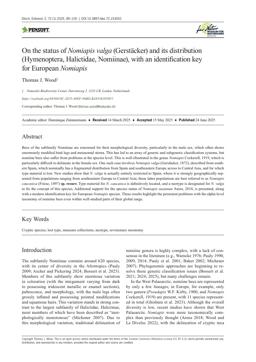2025-06-24
On the status of Nomiapis valga (Gerstäcker) and its distribution (Hymenoptera, Halictidae, Nomiinae), with an identification key for European Nomiapis
Publication
Publication
Deutsche Entomologische Zeitschrift , Volume 72 - Issue 1 p. 85- 100
Bees of the subfamily Nomiinae are renowned for their morphological diversity, particularly in the male sex, which often shows enormously modified hind legs and metasomal sterna. This has led to an array of generic and subgeneric classification systems, but nomiine bees also suffer from problems at the species level. This is well-illustrated in the genus Nomiapis Cockerell, 1919, which is particularly difficult to delineate in the female sex. One such case involves Nomiapis valga (Gerstäcker, 1872), described from southern Spain, which nominally has a fragmented distribution from Spain and southeastern Europe across to Central Asia, and for which type material is lost. New studies show that N. valga is actually entirely restricted to Spain, where it is strongly geographically separated from populations ranging from southeastern Europe to Central Asia; these latter populations are best referred to as Nomiapis caucasica (Friese, 1897) sp. resurr. Type material for N. caucasica is definitively located, and a neotype is designated for N. valga to fix the concept of this species. Additional support for the species status of Nomiapis susannae Arens, 2018, is presented, along with a modern identification key for European Nomiapis species. These results highlight the persistent problems with the alpha-level taxonomy of nomiine bees even within well-studied parts of their global range.
| Additional Metadata | |
|---|---|
| , , , , | |
| doi.org/10.3897/dez.72.153052 | |
| Deutsche Entomologische Zeitschrift | |
| Released under the CC-BY 4.0 (“Attribution 4.0 International”) License | |
| Organisation | Staff publications |
|
Wood, T. (2025). On the status of Nomiapis valga (Gerstäcker) and its distribution (Hymenoptera, Halictidae, Nomiinae), with an identification key for European Nomiapis. Deutsche Entomologische Zeitschrift, 72(1), 85–100. doi:10.3897/dez.72.153052 |
|
